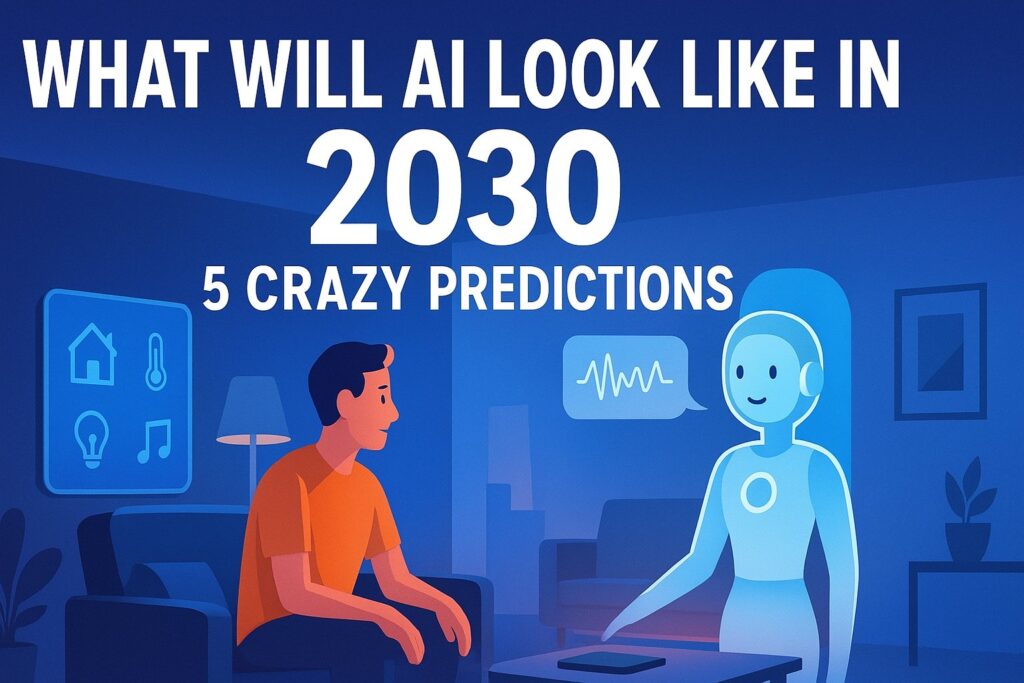When you hear people discussing the future of artificial intelligence, the debate is often cast in the realm of fantastical science fiction, like robots taking over, for example, or artificial intelligence replacing entire companies’ workforces, or some part of a dystopian society that we could all do without.
Personally, I think it’s much more interesting (and useful) to root these conversations in what’s manifesting today.
If you’re watching the patterns and trends in AI, like I have been, you’ll realize that the true story is happening on the ground, quietly brewing away in labs, in startups and in even our homes.
Over the past year, I’ve been diving into research papers, testing early AI tools, and following what’s happening in labs and startups across the world. And believe me, the true narrative is more exciting than any sci-fi thriller.
Based on what I’ve seen and learned, here are 5 predictions about AI in 2030 that I believe are not only realistic but already taking shape.

1. Homes That Respond Like a Living Organism
A few months ago, I had the chance to step inside a next-gen smart home, and the experience completely changed how I think about living spaces. It wasn’t just about voice commands or app-controlled devices.
The entire house was designed to respond intuitively, adjusting lights, temperature, even music, without me lifting a finger.
I think by 2030 home will be that very physical, very embedded-outside-of-just-our-minds kind of place, almost an extension of our bodies.
You walk into the kitchen, and the system knows you’ve already indicated that you’re going to want a strong coffee, or the bedroom temp adjusts based on how deep in your sleep cycle you currently are.
And not just comfort: They will support health, monitoring wellness data, flagging odd-looking data points and even alerting doctors when they need to intervene.
I see a future where our houses don’t just shelter us, but also become actively involved in looking after us.
For millions of people, this will also include new opportunities, such as creating an AI-powered online side hustle, with the home acting as a vehicle for automated work and passive income. Of course, with every wave of innovation comes hype.
2) Brain Chips That Bridge Human and Machine
One of the most exciting breakthroughs I encountered was the case of an individual born blind who was given vision for the first time using a brain-computer interface. A tiny chip connected her brain directly to a camera, bypassing the eyes entirely. Within days, she was perceiving shapes and letters.
This isn’t speculation, it’s real. And I think we will probably see many more of these applications by 2030.
These brain-computer interfaces won’t just help restore senses; they could fundamentally change how we interact with technology altogether. Typing, gaming, or even designing could one day be done purely through thought.
There are real ethical and safety concerns. Could anything so intimate be hacked? Could it be misused? These are valid concerns, but in my experience, the best research teams treat safety as a first-class requirement.
It is my own opinion that the potential benefits —Independence restored, communication optimized, creativity harnessed — will outweigh the risk if managed appropriately.
3) AI Companions That Genuinely Understand Us
I’ll be honest, when I first heard about AI companions, I thought it sounded gimmicky. But the more prototypes I see, the more I realize their potential.
These aren’t just glorified chatbots. They’re systems that are learning to recognize tone, emotion, context, and respond in ways that feel meaningful.
Think about a student under stress who can chat with an AI coach who understands how to relax them. Or an older person who gets companionship every day from a social robot with long conversations about their favorite subjects, besides, who also reminds them to take their medication.
I have watched loneliness and mental health as increasing challenges in society, and where I think AI could do a surprisingly good job is actually on the positive side of things. I think AI could play a surprisingly positive role.
By 2030, I believe AI companions will be as normal as smartphones are today—not replacing human relationships, but filling in the gaps where people feel isolated.
There’s also a scrappy builder angle here. Solo creators are already testing AI companions for coaching, teaching, and customer onboarding.
4) The Rise of Decentralized AI
Something I worry about with today’s AI landscape is how centralized it is. A few big tech companies own most of the data, algorithms and computing power. That is an enormous influence, all in the hands of very few people.
But I’m also seeing a counter-movement, projects building decentralized AI systems where data and models aren’t locked into corporate silos.
Some rely on blockchain, others on distributed networks, but the idea is the same: provide people greater control over their data and make systems more transparent.
I think it will be mainstream by 2030. It might be capable of making AI fairer, more secure and less open to abuse. Decentralization is, in my opinion, one of the biggest changes of the coming decade, and one that will require businesses to rethink how AI is built and shared.
If we do hit an AI bubble burst, decentralized architectures will likely be where the resilient value remains. They allow communities to own the rails — so when marketing winds down, the railroads can trundle on.
5. AI That Becomes Invisible in Daily Life
Here’s the boldest prediction: in 2030, most people won’t even realize how much AI they’re using. It won’t feel like a separate technology anymore—it’ll just be the background of everything we do.
I’ve already seen this in my own work. The tools I use all day, from summarizing reports to making design drafts, save me hours. And half the time, I forget that they’re even “AI tools. That’s exactly where we’re heading.
Think about electricity. We don’t wonder at it every time we flip a light switch, dry the year where life suddenly fails without it.
By 2030, AI will seem like that, invisible but vital. Powering everything from health care to logistics to education to entertainment — quietly, in the background, just getting things faster, smarter and more personalized.
This is where the hard questions land: industries AI replaces and where humans stay irreplaceable. Expect heavy automation in repetitive pattern-recognition tasks: back-office ops, first-line customer support, some radiology pre-reads, quality control on the manufacturing floor and a good chunk of low-sophistication analytics.
But replacement isn’t everything; many roles will be imbued with fresh meaning around judgment, taste and accountability.
Looking Ahead: AI in 2030 Is About Enhancement, Not Replacement
When I connect these five predictions together, one theme stands out: AI in 2030 won’t just make machines smarter, it’ll make human life richer.
Yes, there will be risks, and yes, ethical discussions will continue. But from what I’ve known from the research I’ve done myself and lived, the trajectory is pretty clear.
Instead, AI is evolving to position itself not just as a “tool we use,” but as a partner in how we live, work and yes, even heal.
So when people ask me, ‘What will AI look like in 2030?’ I try not to get into robots taking over the world.
I tell them it will resemble your home, being able to predict your needs, your mind interfacing smoothly with technology, your health being monitored continuously in real time, your daily life seamlessly supported by systems you hardly notice.
The future isn’t science fiction anymore. It’s arriving, step by step, experiment by experiment. And if this is just a taste of what’s to come, then 2030 is going to be an incredible year for artificial intelligence.

